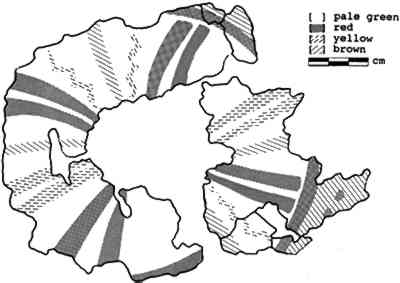FROM CODEX TO CALABASH: RECOVERY OF A PAINTED ORGANIC ARTIFACT FROM THE ARCHAEOLOGICAL SITE OF CER�N, EL SALVADORHARRIET F. BEAUBIEN
6 INTERPRETATION OF THE ARTIFACT REMAINSUnlike any known codex, the overall application of color and radiating design scheme of layer 4 suggest instead a rounded container with a decorated exterior, painted monochromatically on the interior (layer 3) (fig. 4). A comparable decorative approach can be found in contemporaneous Copador-style ceramics, which mimic the radiating segments of gourds or melons in their design (Beaudry 1989; SARCAR). The concave curvature around the edge of layer 4 likely reflects the original form of the artifact rather than distortion from the lifting process, ash and debris having lodged around the base prior to its collapse.
The impressions on the reverse of layer 3 offer the most persuasive argument for a gourd as the now-disintegrated organic substrate (fig. 5). They record an interlocking fibrous mesh with a coarse texture and radiating ribs, characteristic of a gourd's interior morphology (Heiser 1979; Florian et al. 1990), also seen on the reverses of layer 2
Convincing comparisons can be made with several other artifacts excavated during the 1990 field season in a structure identified as a kitchen (Structure 11) (Mobley-Tanaka 1990). Because of the relative openness of the building, these items were accessible to and engulfed by the first fine surge of tephra, which preserved the paint layers in their original configuration. In a lifting method devised by the archaeologists, the interior ash was removed, and the concavity was filled with dental plaster to provide support for the fragile paint layer that articulated the outside surface. While the plaster filling made subsequent identification of the substrate impossible, the hemispherical form of the containers was preserved. Despite their differences in preservation, these artifacts were otherwise comparable to the niche artifact in paint application technique, decorative schemes, and pigments employed. Based upon their association with either food preparation areas or ceramic serving vessels, they are all likely to have been food serving containers, although no residues were detected in any of the objects. It is quite possible that unidentified deposits of paint reported in excavations of other Maya sites once decorated organic substrates such as calabashes. One artifact from the ceremonial site of Tik�l, Guatemala, lifted in 1965 using plaster of Paris and on display in the site museum, may well be an example (Greene 1992). Even more direct evidence comes from the Sacred Cenote at the site of Chich�n Itz�, in the Yucat�n Peninsula, an important Maya ritual center (Coggins and Shane 1984; Ediger 1983). Archaeological dredgings in 1904 and more systematic underwater explorations in 1967 of this natural limestone sinkhole yielded fragments of ornately painted gourds. Edward Herbert Thompson described the findings of the earlier effort as including “gourds coated with the same whitish enamel used on terracotta vessels and painted or hieroglyphed. The gourds were undoubtedly used not only for containers for liquids but for other things such as corn and beans, as they are used by the modern Mayas” (quoted in Wilson 1947, 4). Further evidence of the use of calabashes in the daily life of the Maya is detailed in an account written in 1566 by the Spanish prelate Diego de Landa. In Relaci�n de las Cosas de Yucat�n, he writes in the section on food |

